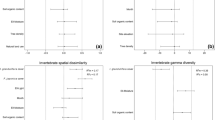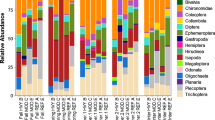Abstract
Invasive alien organisms can impact adversely on indigenous biodiversity, while riparian invasive alien trees (IATs), through shading of the habitat, can be a key threat to stream invertebrates. We ask here whether stream fauna can recover when the key threat of riparian IATs is removed. Specifically, we address whether IAT invasion, and subsequent IAT removal, changes benthic macroinvertebrate and adult dragonfly assemblages, for the worse or for the better respectively. Natural riparian zones were controls. There were statistically significant differences between stream reaches with natural, IAT-infested and IAT-cleared riparian vegetation types, based on several metrics: immature macroinvertebrate taxon richness, average score per macroinvertebrate taxon (ASPT), a macroinvertebrate subset (Ephemeroptera, Plecoptera, Trichoptera and Odonata larvae; EPTO), and adult dragonfly species richness. Reaches with natural vegetation, or cleared of IATs, supported greater relative diversity of macroinvertebrates than reaches shaded by dense IATs. Greatest macroinvertebrate ASPT and EPTO were in reaches bordered by natural vegetation and those bordered by vegetation cleared of IATs, and the lowest where the riparian corridor was IATs. Highest number of adult dragonflies species was along streams cleared of dense IATs. Overall, results showed that removal of a highly invasive, dense canopy of alien trees enables recovery of aquatic biodiversity. As benthic macroinvertebrate scores and adult dragonfly species richness are correlated and additive, their combined use is recommended for river condition assessments.





Similar content being viewed by others
References
Armitage PD, Moss D, Wright JF, Furse MT (1983) The performance of a new biological water quality score system based on macroinvertebrates over a wide range of unpolluted running-water sites. Water Res 17:333–347
Boon PJ (1988) The impact of river regulation on invertebrate communities in the UK. Reg Rivers Res Manag 2:389–409
Buchwald R (1992) Vegetation and dragonfly fauna - characteristics and examples of biocenological field studies. Vegetatio 101:99–107
Bulánková E (1997) Dragonflies (Odonata) as bioindicators of environmental quality. Biologia 52:177–180
Butler RG, deMaynadier PG (2008) The significance of littoral and shoreline habitat integrity to the conservation of lacustrine damselflies (Odonata). J Insect Conserv 12:23–36
Calder IR (1999) The blue revolution: land use and integrated water resources management. Earthscan, London
Chovanec A, Waringer J (2001) Ecological integrity of river-floodplain systems-assessment by dragonfly surveys (Insecta: Odonata). Reg Rivers Res Manag 17:493–507
Chwala E, Waringer J (1996) Association patterns and habitat selection of dragonflies (Insecta: Odonata) at different types of Danubian backwaters at Vienna, Austria. Arch Hydrobiol Suppl Large Rivers 115:45–60
Clark TE, Samways MJ (1996) Dragonflies (Odonata) as indicators of biotope quality in the Kruger National Park, South Africa. J Appl Ecol 33:1001–1012
Clarke KR, Warwick RM (2001) Change in marine communities: an approach to statistical analysis and interpretation, 2nd edn. PRIMER-E, Plymouth
Clavero M, Garcia-Berthou E (2005) Invasive species are a leading cause of animal extinctions. Trends Ecol Evol 20:110
Culp JM, Walde SJ, Davies RW (1983) Relative importance of substrate particle size and detritus to stream benthic macroinvertebrate microdistribution. Can J Fish Aquat Sci 40:1568–1574
D’Amico FD, Darblade S, Avignon S, Blanc-Manel S, Ormerod SJ (2004) Odonates as indicators of shallow lake restoration by liming: comparing adult and larval responses. Restor Ecol 12:439–446
Dickens CWS, Graham PM (2002) The South African scoring system (SASS) version 5 rapid bioassessment system for rivers. Afr J Aquatc Sci 27:1–10
Diedericks GJ (2002) Assessment of stream conditions draining Mondi and SAFCOL commercial tree plantations in the Limpopo catchment, using SASS5. Internal report for Mondi Forests and SAFCOL, South Africa
Dinakaran S, Anbalagan S (2007) Anthropogenic impacts on aquatic insects in six streams of south Western Ghats. J Insect Sci 7:37
Dobson M, Hildrew AG (1992) A test of resource limitation among shredding detritivores in low order streams in southern England. J Anim Ecol 61:69–77
Dye P, Jarmain C (2004) Water use by black wattle (Acacia mearnsii): implications for link between removal of invading trees and catchment streamflow response. Sth Afr J Sci 100:40–44
Foote AL, Hornung CLR (2005) Odonates as biological indicators of grazing effects on Canadian prairie wetlands. Ecol Entomol 30:273–283
Foster SE, Soluk DA (2004) Evaluating exuvia collection as a management tool for the Federally endangered Hine’s emerald dragonfly, Somatochlora hineana Williamson (Odonata: Cordulidae). Biol Conserv 118:15–20
Hawking JH, New TR (1999) The distribution patterns of dragonflies (Insecta: Odonata) along the Kiewa River, and their relevance in conservation assessment. Hydrobiologia 392:249–260
Hawkins CP, Norris RH (2000) Performance of different landscape classifications for aquatic bioassessment: introduction to the series. J North Am Benthol Soc 16:728–749
Hawkins CPM, Murphy ML, Anderson NH (1982) Effects of canopy, substrate composition, and gradients on the structure of macroinvertebrate communities in Cascade Range streams of Oregon. Ecology 62:387–397
Hildrew AG, Townsend CR (1976) The distribution of two predators and their prey in an iron rich stream. J Anim Ecol 45:41–57
Hirji R, Johnson P, Maro P, Matiza Chiuta T (2002) Defining and mainstreaming environmental sustainability in water resources in southern Africa. SADC, IUCN, SARDC, World Bank, Maseru
Hofmann TA, Mason CF (2005) Habitat characteristics and the distribution of Odonata in a lowland river catchment in eastern England. Hydrobiologia 539:137–147
Inc SPSS (2006) SPSS version 15.0 for windows. SPSS Inc, Chicago
Kinvig R, Samways MJ (2000) Conserving dragonflies along streams running through commercial foestry. Odonatologica 29:195–208
Latimer AM, Silander JA, Gelfand AE, Rebelo AG, Richardson DM (2004) Quantifying threats to biodiversity from invasive alien plants and other factors: a case study from the Cape Floristic Region. Sth Afr J Sci 100:81–86
Magoba RNN (2005) Effect of invasion and clearing of alien riparian vegetation on benthic macroinvertebrate and adult Odonata assemblages in Soutpansberg rivers. MSc Thesis, University of Stellenbosch, South Africa
Marden JH, Cobb JR (2004) Territorial and mating success of dragonflies that vary in muscle power output and presence of gregarine gut parasites. Anim Behav 68:857–865
Merz JE, Ochikubo Chan LK (2005) Effects of gravel augmentation on macroinvertebrate assemblages in a regulated California river. River Res Applic 21:61–74
Metcalfe JL (1989) Biological water quality assessment of running waters based on macroinvertebrate communities: history and present status in Europe. Environ Pollut 60:101–139
Moore NW (1991) The development of dragonfly communities and the consequences of territorial behaviour: a 27-year study of small ponds at Woodwalton Fen, Cambridgeshire, United Kingdom. Odonatologica 20:203–231
Norris RH, Thoms MC (1999) What is river health? Freshw Biol 41:197–209
Orians GH, Wittenberger JF (1991) Spatial and temporal scales in habitat selection. Am Nat 137:S29–S49
Quinn JM, Hickey CW (1994) Hydraulic parameters and benthic invertebrate distributions in two gravel-bed New Zealand rivers. Freshw Biol 32:489–500
Rempel LL, Richardson JS, Healey MC (2000) Macroinvertebrate community structure along gradients of hydraulic and sedimentary conditions in large gravel-bed river. Freshw Biol 45:57–73
Resh VH, Jackson JK (1993) Rapid assessment approaches to biomonitoring using benthic macroinvertebrates. In: Rosenberg DM, Resh VH (eds) Freshwater biomonitoring and benthic macroinvertebrates. Chapman and Hall, New York
Richardson DM, Van Wilgen BW (2004) Invasive alien plants in South Africa: how well do we understand the ecological impacts? Sth Afr J Sci 100:45–52
Rith-Najarian JC (1998) The influence of forest vegetation variables on the distribution and diversity of dragonflies in a northern Minnesota forest landscape: a preliminary study (Anisoptera). Odonatologica 27:335–351
Samways MJ (1989) Insect conservation and the disturbance landscape. Agric Ecosyst Environ 27:183–194
Samways MJ (2007) Threat levels to odonate assemblages from invasive alien tree canopies. In: Cordero Rivera A (ed) Forests and dragonflies. Pensoft, Sophia, pp 209–224
Samways MJ, Sharratt NJ (2010) Recovery of endemic dragonflies after removal of invasive alien trees. Conserv Biol 24:267–277
Samways MJ, Steytler NS (1996) Dragonfly (Odonata) distribution patterns in urban and forest landscapes, and recommendations for riparian management. Biol Conserv 78:279–288
Samways MJ, Taylor S (2004) Impacts of invasive alien plants on red-listed South African dragonflies (Odonata). Sth Afr J Sci 100:78–80
Samways MJ, Caldwell PM, Osborn R (1996) Spatial patterns of dragonflies (Odonata) as indicators for design of a conservation pond. Odonatologica 25:157–166
Samways MJ, Taylor S, Tarboton W (2005) Extinction reprieve following alien removal. Conserv Biol 19:1329–1330
Sarriquet PE, Bordenave P, Marmonier P (2007) Effects of bottom sediment restoration on interstitial habitat characteristics and benthic macroinvertebrate assemblages in a headwater stream. River Res Applic 23:815–828
Schindler M, Fesl C, Chovanec A (2003) Dragonfly associations (Insecta: Odonata) in relation to habitat variables: a multivariate approach. Hydrobiologia 497:169–180
Sheldon AL (1986) Species diversity and longitudinal succession in stream fishes. Ecology 49:193–198
Simaika JP, Samways MJ (2008) Reserve selection using red listed taxa in three global biodiversity hotspots: dragonflies in South Africa. Biol Conserv 142:638–651
Simaika JP, Samways MJ (2009) An easy-to-use index of ecological integrity for prioritizing freshwater sites and for assessing habitat quality. Biodivers Conserv 18:1171–1185
Smith J, Samways MJ, Taylor S (2007) Assessing riparian quality using two complementary sets of bioindicators. Biodivers Conserv 16:2695–2713
Stewart DAB, Samways MJ (1998) Conserving dragonfly (Odonata) assemblages relative to river dynamics in an African savanna game reserve. Conserv Biol 12:683–692
Suh AN, Samways MJ (2001) Development of a dragonfly awareness trail in an African botanical garden. Biol Conserv 100:345–353
Switzer PV (1997) Factors affecting site fidelity in a territorial animal, Perithemis tenera. Anim Behav 53:865–877
Tallamy DW (2004) Do alien plants reduce insect biomass? Conserv Biol 18:1689–1692
Ter Braak CJF, Šmilauer P (2002) CANOCO reference manual and user’s guide to Conoco for Windows: software for Canonical Community Ordination (version 4.5). Microcomputer Power, Ithaca, NY
Townsend CR, Hildrew AG (1994) Species traits in relation to a habitat templet for river systems. Freshw Biol 31:265–275
Ulfstrand S (1967) Microdistribution of benthic species (Ephemeroptera, Plecoptera, Trichoptera, Diptera: Simuliidae) in Lapland streams. Oikos 18:293–310
Water Research Commission (2001) State of rivers report: Crocodile, Sabie, Sand, and Olifants river systems. RSA, WRC Report No.TT 147/01
Wittenberg R, Cock MJW (eds) (2001) Invasive alien species: a toolkit of best prevention and management practices. CAB International, Wallington
Wright JF, Moss D, Armitage PD, Furse MT (1984) A preliminary classification of running-water sites in Great Britain based on macro-invertebrate species and the prediction of community type using environmental data. Freshw Biol 14:221–256
Zimmermann HG, Moran VC, Hoffmann JH (2004) Biological control in the management of invasive alien plants in South Africa, and the role of the Working for Water Programme. Sth Afr J Sci 100:34–40
Acknowledgments
We thank Steven Lumber Mills and Komatiland Forest for allowing access to their plantations, S. Taylor for logistic support, and G. Diedericks for access to his internal report. We especially thank R. Madzivhe, M. Tshikalange, G. Maluleke and L. Magoba for assistance in the field. Financial support was from the Working for Water Programme.
Author information
Authors and Affiliations
Corresponding author
Rights and permissions
About this article
Cite this article
Magoba, R.N., Samways, M.J. Recovery of benthic macroinvertebrate and adult dragonfly assemblages in response to large scale removal of riparian invasive alien trees. J Insect Conserv 14, 627–636 (2010). https://doi.org/10.1007/s10841-010-9291-5
Received:
Accepted:
Published:
Issue Date:
DOI: https://doi.org/10.1007/s10841-010-9291-5




